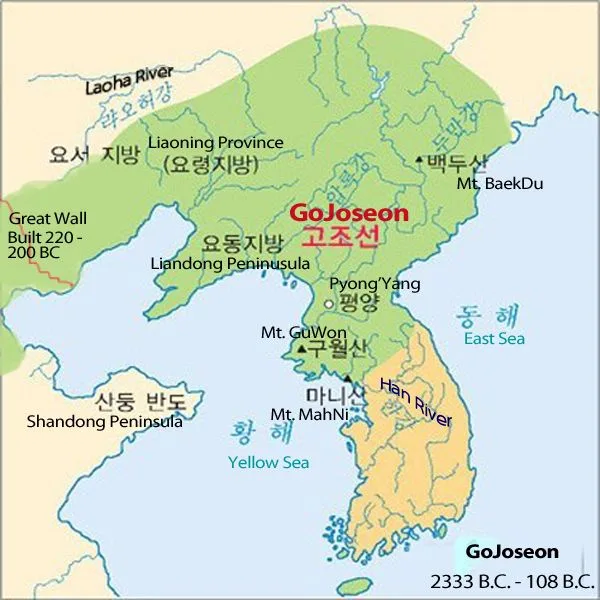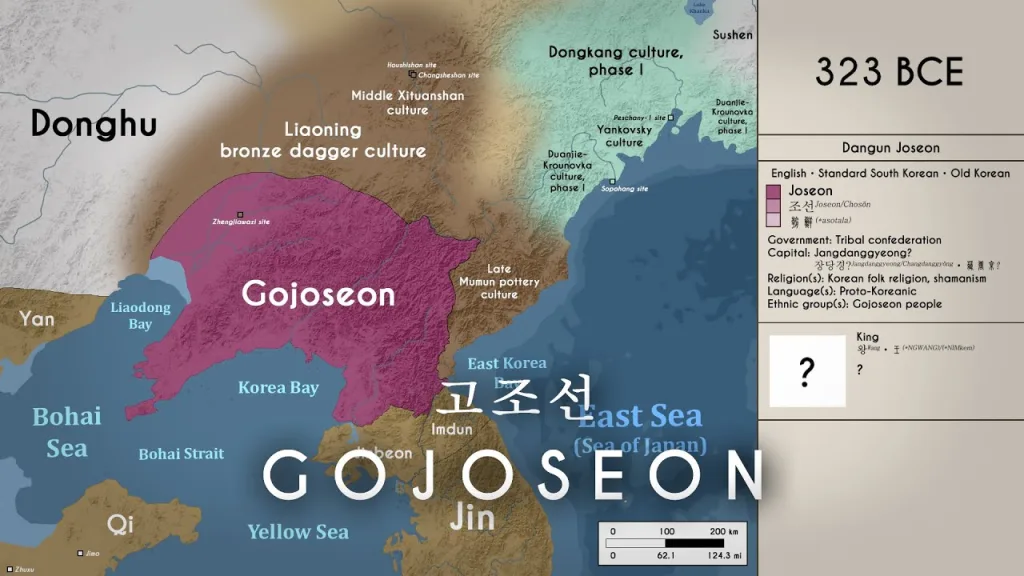As we are continuing our Journey in the Korean history, we are going to stop in every important period. Today our trip will be in Gojoseon which was the first kingdom on the Korean Peninsula. According to Korean mythology, the kingdom was established by the legendary king Dangun
Gojoseon, the earliest known Korean state, existed from around 2333 BC to 108 BC. This era, shrouded in both history and mythology, lays the foundation for Korean identity and national pride.

Mythical Founding
The origins of Gojoseon are deeply intertwined with legend and symbolism.
Dangun Wanggeom: According to myth, Gojoseon was founded by Dangun Wanggeom, the son of Hwanung, a divine figure, and a bear-woman. The story, recorded in ancient Korean texts like the Samguk Yusa, represents a sacred connection between the heavens and the people of Korea.
Symbolism and Beliefs: The myth serves as a foundational narrative in Korean folklore, reinforcing ideas of divine rule and ancestral unity. Today, Dangun is celebrated annually on Gaecheonjeol (National Foundation Day), honoring Korea’s mythical beginnings.
Historical Records and Development
Though historical accounts of Gojoseon remain fragmented, archaeological findings and Chinese historical texts like the Records of the Grand Historian (Shiji) provide insight into its existence.

Early Political Structure: Gojoseon is believed to have evolved into a centralized kingdom, moving away from its early tribal federation. King Jun and later King Wiman played crucial roles in shaping its political landscape.
Interactions with China: Gojoseon maintained diplomatic and trade relations with ancient Chinese states, influencing its governance, military strategies, and technology. However, growing tensions led to conflicts with the Han Dynasty, which eventually led to its decline.
Culture and Society
Agriculture and Economy: The kingdom thrived on agriculture, cultivating crops like rice, barley, and millet. The use of bronze tools marked advancements in farming and craftsmanship.
Social Hierarchy: Society was structured under a ruling elite, supported by aristocratic and commoner classes. The influence of Chinese governance introduced bureaucratic systems, strengthening administrative control.
Laws and Justice: Gojoseon established a legal code, including the famous Eight Prohibitions, which governed crimes such as murder and theft—an early example of formalized legal principles in East Asia.
Legacy and Influence
Korean National Identity: Gojoseon’s legacy persists in modern Korea’s sense of historical pride. The idea of an ancient, unified kingdom remains a cornerstone in national consciousness.
Cultural Heritage: From literature to art, traces of Gojoseon’s traditions are found in various aspects of Korean culture. The myth of Dangun continues to be commemorated, emphasizing Korea’s spiritual roots.
Ongoing Research and Debates
Archaeological Discoveries: Excavations of dolmens, bronze artifacts, and remnants of ancient settlements provide valuable clues about daily life in Gojoseon.
Historical Controversies: Some scholars debate the veracity of Dangun’s story, questioning its role in shaping historical versus mythological narratives. Despite differing interpretations, Gojoseon remains an essential topic in Korean historiography.
